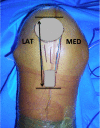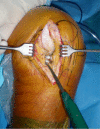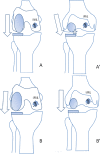Lateral unicondylar knee arthroplasty (UKA): contemporary indications, surgical technique, and results
- PMID: 24337799
- PMCID: PMC3923949
- DOI: 10.1007/s00264-013-2222-9
Lateral unicondylar knee arthroplasty (UKA): contemporary indications, surgical technique, and results
Abstract
Unicompartmental femoro-tibial osteoarthritis usually affects the medial compartment of the knee, but in 10%, the lateral compartment is primarily involved. Femoral osteotomy is attractive to avoid TKA in younger patients with low-grade unicompartmental osteoarthritis and a valgus deformity. However, only limited functional results can be expected for patients with Ahlback grade 2 or greater osteoarthritis. Moreover, because of previous skin incisions and hardware removal, TKA after femoral osteotomy remains a complex procedure with poor functional results. Unicompartmental knee arthroplasty for both the medial and the lateral compartments has been performed since the 1970s. In a patient with involvement of only one compartment, a medial or a lateral UKA can provide a quicker recovery and enhanced function when compared to TKA. In addition, it preserves bone stock and can be "easily" revised by a TKA. Technical improvements, combined with strict patient selection, have resulted in ten year survivorships greater than 90%. However, lateral UKA is technically more challenging than medial UKA due to the lower number of indications, as well as the functional anatomy of the lateral compartment. The goals of this article are to present up-to-date information concerning indications, patients' selection, surgical technique and results of lateral compartment UKA.
Figures








Similar articles
-
Differences in impact on adjacent compartments in medial unicompartmental knee arthroplasty versus high tibial osteotomy with identical valgus alignment.Knee. 2021 Mar;29:241-250. doi: 10.1016/j.knee.2021.02.017. Epub 2021 Mar 3. Knee. 2021. PMID: 33676319
-
Patterns of Compartment Involvement in End-stage Knee Osteoarthritis in a Chinese Orthopedic Center: Implications for Implant Choice.Orthop Surg. 2018 Aug;10(3):227-234. doi: 10.1111/os.12395. Orthop Surg. 2018. PMID: 30152607 Free PMC article. Review.
-
The Location and Severity of Preoperative Subchondral Bone Marrow Lesions Were Not Associated With Inferior Postoperative Outcomes After Medial Unicompartmental Knee Arthroplasty or Total Knee Arthroplasty.J Arthroplasty. 2016 Nov;31(11):2476-2480. doi: 10.1016/j.arth.2016.05.009. Epub 2016 May 11. J Arthroplasty. 2016. PMID: 27286910
-
Unicompartmental Knee Arthroplasty Provides Significantly Greater Improvement in Function than Total Knee Arthroplasty Despite Equivalent Satisfaction for Isolated Medial Compartment Osteoarthritis.J Arthroplasty. 2019 Aug;34(8):1611-1616. doi: 10.1016/j.arth.2019.04.005. Epub 2019 Apr 8. J Arthroplasty. 2019. PMID: 31031160
-
Unicondylar knee arthroplasty: intramedullary technique.Clin Sports Med. 2014 Jan;33(1):87-104. doi: 10.1016/j.csm.2013.08.004. Clin Sports Med. 2014. PMID: 24274848 Review.
Cited by
-
[Experiences with lateral unicondylar prostheses].Orthopade. 2014 Oct;43(10):913-22. doi: 10.1007/s00132-014-3021-8. Orthopade. 2014. PMID: 25227531 Review. German.
-
Biomechanical finite element analysis of various tibial plateau posterior tilt angles in medial unicondylar knee arthroplasty.Exp Ther Med. 2024 Jul 5;28(3):353. doi: 10.3892/etm.2024.12641. eCollection 2024 Sep. Exp Ther Med. 2024. PMID: 39071913 Free PMC article.
-
Survival of medial versus lateral unicompartmental knee arthroplasty: A meta-analysis.PLoS One. 2020 Jan 24;15(1):e0228150. doi: 10.1371/journal.pone.0228150. eCollection 2020. PLoS One. 2020. PMID: 31978110 Free PMC article.
-
Knee arthroplasty today.Int Orthop. 2014 Feb;38(2):221-5. doi: 10.1007/s00264-013-2274-x. Int Orthop. 2014. PMID: 24420157 Free PMC article. No abstract available.
-
Clinical Results of Lateral Unicompartmental Knee Arthroplasty: Minimum 2-Year Follow-up.Clin Orthop Surg. 2016 Dec;8(4):386-392. doi: 10.4055/cios.2016.8.4.386. Epub 2016 Nov 4. Clin Orthop Surg. 2016. PMID: 27904720 Free PMC article.
References
-
- Ahlback S. Osteoarthrosis of the knee. A radiographic investigation. Acta Radiol Diagn. 1968;277:7–72. - PubMed
-
- Argenson JN, Chevrol-Benkeddache Y, Aubaniac JM. Modern unicompartmental knee arthroplasty with cement: a three- to ten-year follow-up study. J Bone Joint Surg Am. 2002;84(12):2235–2239. - PubMed
Publication types
MeSH terms
LinkOut - more resources
Full Text Sources
Other Literature Sources
Medical

